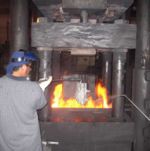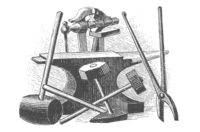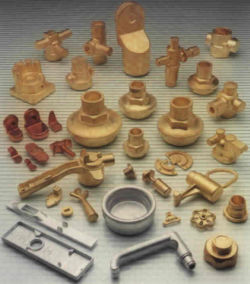Forging
From DDL Wiki
Contents |
Process
Forging is another process used to shape metals, but with several key differences from machining or casting. With forging, the shaping takes place through plastic deformation. Traditionally, this was done by black smiths, hammering the material into shape while resting it on an even harder surface, the anvil. In modern forges the work is done by a machine, such as a hydrolic press, where the metal is sandwiched between two die halves. These dies are subsiquently pressed together with a gradually increasing force. One advantage of using plastic deformation is the strengthening properties of the process. As the material deforms, the grains become aligned, increasing the strength of the material. However, some metals, such as iron, become too hard if they are forged cold. For these materials, hot forging ensures they remain suitably pliable througout the forging process. For hot forging, the metal is heated prior to being deformed and quenched in a water bath (slack tub) afterwards.
Tools
- Hammer
- Tongs
- Anvil
- Bellows
- Slack tub
Costs
The costs of forging are widely variable, depending on several factors. Harder metals will require more force to forge, dramatically increasing the price of the machinery in modern, automated forging. For manual forging, whether it is hot or cold will have a great impact on costs, as hot forging will require a hearth, bellows, and fuel.
Forgeable Materials and Components
Forging is almost exclusively used for shaping metals. Softer materials such as wood would not stand up under the rigorous conditions of the forging process. Most metals are cold forged, however, a few select materials benefit from hot forging to prevent excessive work hardening. Hot Forgable Metals:
- Iron
- Steel
- Aluminum
- Titanium
These materials are hot forged because they can easily be hardened after forging through other processes like heat treating. Most other metals should be cold forged because the strength they gain through plastic deformation cannot be achieved through other processes.
With advances in modern forging processes and the use of dies, just about any metal component can be forged. However, dies and heavy machinery are needed, so forging is expensive and therefore is used predominantly for producing large quantities. Also, due to the strengthening this process is often chosen for components where failure would be catastrophic.
Relevance to Design
Forging should be chosen for components that require very high strength. As the metal is repeatedly heated, shaped, and cooled, the grain actually changes to flow with the shape of the part, resulting in a larger strength than casting or machining. The act of quenching the heated metal also acts as a heat treatment, increasing the material's hardness. This process has an advantage over machining parts in that no material is cut away and wasted. Especially for more expensive materials, this reduction in waste would result in significant savings. Forging also has advantages over casting in some circumstances. In addition to the added strength from forging, the aligning the grain of the material also helps remove defects. Defects in the material often lead to stress concentrations, resulting in failure at lower loads. Casting cannot avoid such defects as the metal cools, but forging works those defects out of the material. This means forging is preferable to casting in the creation of components where its failure would have serious repercussions. Forging does have some limitations. One is that forging cannot handle some of the larger components that machining can. Also, in general the components created by forging must be somewhat simpler than those of other processes. Therefore, when making relatively large or complex parts, forging may not be the ideal choice of manufacturing processes.



